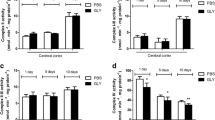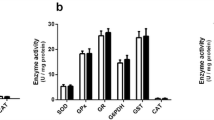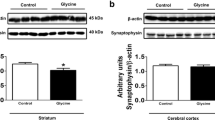Abstract
High tissue levels of glycine (GLY) are the biochemical hallmark of nonketotic hyperglycinemia (NKH), an inherited metabolic disease clinically characterized by severe neurological symptoms and brain abnormalities. Considering that the mechanisms underlying the neuropathology of this disease are not fully established, the present work investigated the in vivo effects of intracerebroventricular administration of GLY on important parameters of energy metabolism in cerebral cortex and striatum from young rats. Our results show that GLY reduced CO2 production using glucose as substrate and inhibited the activities of citrate synthase and isocitrate dehydrogenase in striatum, whereas no alterations of these parameters were verified in cerebral cortex 30 min after GLY injection. We also observed that GLY diminished the activities of complex IV in cerebral cortex and complex I–III in striatum at 30 min and inhibited complex I–III activity in striatum at 24 h after its injection. Furthermore, GLY reduced the activity of total and mitochondrial creatine kinase in both brain structures 30 min and 24 h after its administration. In contrast, the activity of Na+, K+-ATPase was not altered by GLY. Finally, the antioxidants N-acetylcysteine and creatine, and the NMDA receptor antagonist MK-801 attenuated or fully prevented the inhibitory effects of GLY on creatine kinase and respiratory complexes in cerebral cortex and striatum. Our data indicate that crucial pathways for energy production and intracellular energy transfer are severely compromised by GLY. It is proposed that bioenergetic impairment induced by GLY in vivo may contribute to the neurological dysfunction found in patients affected by NKH.







Similar content being viewed by others
References
Applegarth DA, Toone JR (2001) Nonketotic hyperglycinemia (glycine encephalopathy): laboratory diagnosis. Mol Genet Metab 74(1–2):139–146. doi:10.1006/mgme.2001.3224
Applegarth DA, Toone JR, Lowry RB (2000) Incidence of inborn errors of metabolism in British Columbia, 1969–1996. Pediatrics 105(1):e10
Arnold S (2012) The power of life—cytochrome c oxidase takes center stage in metabolic control, cell signalling and survival. Mitochondrion 12(1):46–56. doi:10.1016/j.mito.2011.05.003
Bekiesiniska-Figatowska M, Rokicki D, Walecki J (2001) MRI in nonketotic hyperglycinaemia: case report. Neuroradiology 43(9):792–793
Brenner E, Kondziella D, Haberg A, Sonnewald U (2005) Impaired glutamine metabolism in NMDA receptor hypofunction induced by MK801. J Neurochem 94(6):1594–1603. doi:10.1111/j.1471-4159.2005.03311.x
Busanello EN, Moura AP, Viegas CM, Zanatta A, da Costa Ferreira G, Schuck PF, Wajner M (2010) Neurochemical evidence that glycine induces bioenergetical dysfunction. Neurochem Int 56(8):948–954. doi:10.1016/j.neuint.2010.04.002
Chan KM, Delfert D, Junger KD (1986) A direct colorimetric assay for Ca2+-stimulated atpase activity. Anal Biochem 157(2):375–380
Clay VJ, Ragan CI (1988) Evidence for the existence of tissue specific isoenzymes of mitochondrial NADH dehydrogenase. Biochem Biophys Res Commun 157(3):1423–1428
da Silva CG, Ribeiro CAJ, Leipnitz G, Dutra CS, Wyse ATS, Wannmacher CMD, Sarkis JJF, Jakobs C, Wajner M (2002) Inhibition of cytochrome c oxidase activity in rat cerebral cortex and human skeletal muscle by d-2-hydroxyglutaric acid in vitro. Biochim Biophys Acta 1586(1):81–91. doi:10.1016/S09254439(01)00088-6
da Silva CG, Bueno ARF, Schuck PF, Leipnitz G, Ribeiro CAJ, Rosa RB, Dutra CS, Wyse ATS, Wannmacher CMD, Wajner M (2004) Inhibition of creatine kinase activity from rat cerebral cortex by d-2-hydroxyglutaric acid in vitro. Neurochem Int 44(1):45–52. doi:10.1016/S0197-0186(03)00098-6
Dutra-Filho CS, Wajner M, Wannmacher CM, Gassen E, Candiago R, Wilhelms A, de Malfussi HF (1995) 2-Hydroxybutyrate and 4-hydroxybutyrate inhibit CO2 formation from labeled substrates by rat cerebral cortex. Biochem Soc Trans 23(2):228S
Eyjolfsson EM, Nilsen LH, Kondziella D, Brenner E, Haberg A, Sonnewald U (2011) Altered 13C glucose metabolism in the cortico-striato-thalamo-cortical loop in the MK-801 rat model of schizophrenia. J Cereb Blood Flow Metab 31(3):976–985. doi:10.1038/jcbfm.2010.193
Farbiszewski R, Witek A, Skrzydlewska E (2000) N-acetylcysteine or trolox derivative mitigate the toxic effects of methanol on the antioxidant system of rat brain. Toxicology 156(1):47–55. doi:10.1016/S0300-483X(00)00333-4
Fischer JC, Ruitenbeek W, Berden JA, Trijbels JMF, Veerkamp JH, Stadhouders AM, Sengers RCA, Janssen AJM (1985) Differential investigation of the capacity of succinate oxidation in human skeletal muscle. Clin Chim Acta 153(1):23–36
Frazier DM, Summer GK, Chamberlin HR (1978) Hyperglycinuria and hyperglycinemia in two siblings with mild developmental delays. Am J Dis Child 132(8):777–781
Halliwell B, Gutteridge JMC (2007) Measurement of reactive species. Free radicals in biology and medicine, 4th edn. Oxford University Press, Oxford
Hamosh A, Johnston MV (2001) Non-ketotic hyperglycinemia. In: Scriver CR, Beaudet A, Sly WS, Valle D (eds) The metabolic and molecular bases of inherited disease, 8th edn. McGraw-Hill, New York, pp 2065–2078
Hara H, Sukamoto T, Kogure K (1993) Mechanism and pathogenesis of ischemia-induced neuronal damage. Prog Neurobiol 40(6):645–670. doi:10.1016/0301-0082(93)90009-H
Heindel W, Kugel H, Roth B (1993) Noninvasive detection of increased glycine content by proton MR spectroscopy in the brains of two infants with nonketotic hyperglycinemia. Am J Neuroradiol 14(3):629–635
Hennermann JB, Berger JM, Grieben U, Scharer G, Van Hove JL (2012) Prediction of long-term outcome in glycine encephalopathy: a clinical survey. J Inherit Metab Dis 35(2):253–261. doi:10.1007/s10545-011-9398-1
Hughes BP (1962) A method for estimation of serum creatine kinase and its use in comparing creatine kinase and aldolase activity in normal and pathological sera. Clin Chim Acta 7(5):597–603
Jones DH, Matus AI (1974) Isolation of synaptic plasma membrane from brain by combined flotation–sedimentation density gradient centrifugation. Biochim Biophys Acta 356(3):276–287
Katsuki H, Watanabe Y, Fujimoto S, Kume T, Akaike A (2007) Contribution of endogenous glycine and d-serine to excitotoxic and ischemic cell death in rat cerebrocortical slice cultures. Life Sci 81(9):740–749. doi:10.1016/j.lfs.2007.07.001
Kay L, Nicolay K, Wieringa B, Saks V, Wallimann T (2000) Direct evidence for the control of mitochondrial respiration by mitochondrial creatine kinase in oxidative muscle cells in situ. J Biol Chem 275(10):6937–6944. doi:10.1074/jbc.275.10.6937
Kono Y, Shigetomi E, Inoue K, Kato F (2007) Facilitation of spontaneous glycine release by anoxia potentiates NMDA receptor current in the hypoglossal motor neurons of the rat. Eur J Neurosci 25(6):1748–1756. doi:10.1111/j.1460-9568.2007.05426.x
Kure S, Tada K, Narisawa K (1997) Nonketotic hyperglycinemia: biochemical, molecular, and neurological aspects. Jpn J Hum Genet 42(1):13–22. doi:10.1007/BF02766917
Leipnitz G, Solano AF, Seminotti B, Amaral AU, Fernandes CG, Beskow AP, Dutra Filho CS, Wajner M (2009) Glycine provokes lipid oxidative damage and reduces the antioxidant defenses in brain cortex of young rats. Cell Mol Neurobiol 29(2):253–261. doi:10.1007/s10571-008-9318-6
Lowry OH, Rosebrough NJ, Farr AL, Randall RJ (1951) Protein measurement with the Folin phenol reagent. J Biol Chem 193(1):265–275
Meyer LE, Machado LB, Santiago AP, da-Silva WS, De Felice FG, Holub O, Oliveira MF, Galina A (2006) Mitochondrial creatine kinase activity prevents reactive oxygen species generation: antioxidant role of mitochondrial kinase-dependent ADP re-cycling activity. J Biol Chem 281(49):37361–37371. doi:10.1074/jbc.M604123200
Morrison JF (1954) The activation of aconitase by ferrous ions and reducing agents. Biochem J 58(4):685–692
Paxinos G, Watson C (1986) The rat brain in stereotaxic coordinates, 2nd edn. Academic Press, San Diego
Plaut GWE (1969) Isocitrate dehydrogenase from bovine heart. Methods Enzymol 13:34–42
Rhein V, Baysang G, Rao S, Meier F, Bonert A, Muller-Spahn F, Eckert A (2009) Amyloid-beta leads to impaired cellular respiration, energy production and mitochondrial electron chain complex activities in human neuroblastoma cells. Cell Mol Neurobiol 29(6–7):1063–1071. doi:10.1007/s10571-009-9398-y
Ribeiro CAJ, Grando V, Dutra CS, Wannmacher CMD, Wajner M (2006) Evidence that quinolinic acid severely impairs energy metabolism through activation of NMDA receptors in striatum from developing rats. J Neurochem 99(6):1531–1542. doi:10.1111/j.1471-4159.2006.04199.x
Roemgens A, Singh S, Beyer C, Arnold S (2011) Inducers of chemical hypoxia act in a gender- and brain region-specific manner on primary astrocyte viability and cytochrome C oxidase. Neurotox Res 20(1):1–14. doi:10.1007/s12640-010-9213-z
Rustin P, Chretien D, Bourgeron T, Gerard B, Rotig A, Saudubray JM, Munnich A (1994) Biochemical and molecular investigations in respiratory chain deficiencies. Clin Chim Acta 228(1):35–51
Sauer SW, Opp S, Haarmann A, Okun JG, Kolker S, Morath MA (2009) Long-term exposure of human proximal tubule cells to hydroxycobalamin[c-lactam] as a possible model to study renal disease in methylmalonic acidurias. J Inherit Metab Dis 32(6):720–727. doi:10.1007/s10545-009-1197-6
Schapira AHV, Mann VM, Cooper JM, Dexter D, Daniel SE, Jenner P, Clark JB, Marsden CD (1990) Anatomic and disease specificity of NADH CoQ1 reductase (Complex I) deficiency in Parkinson’s disease. J Neurochem 55(6):2142–2145
Seminotti B, Knebel LA, Fernandes CG, Amaral AU, da Rosa MS, Eichler P, Leipnitz G, Wajner M (2011) Glycine intrastriatal administration induces lipid and protein oxidative damage and alters the enzymatic antioxidant defenses in rat brain. Life Sci 89(7–8):276–281. doi:10.1016/j.lfs.2011.06.013
Sestili P, Martinelli C, Bravi G, Piccoli G, Curci R, Battistelli M, Falcieri E, Agostini D, Gioacchini AM, Stocchi V (2006) Creatine supplementation affords cytoprotection in oxidatively injured cultured mammalian cells via direct antioxidant activity. Free Radic Biol Med 40(5):837–849. doi:10.1016/j.freeradbiomed.2005.10.035
Srere PA (1969) Citrate synthase. Methods Enzymol 13:3–11
Stachowiak O, Dolder M, Wallimann T, Richter C (1998) Mitochondrial creatine kinase is a prime target of peroxynitrite-induced modification and inactivation. J Biol Chem 273(27):16694–16699. doi:10.1074/jbc.273.27.16694
Steiner RD, Sweetser DA, Rohrbaugh JR, Dowton SB, Toone JR, Applegarth DA (1996) Nonketotic hyperglycinemia: a typical clinical and biochemical manifestations. J Pediatr 128(2):243–246
Sundar Boyalla S, Barbara Victor M, Roemgens A, Beyer C, Arnold S (2011) Sex- and brain region-specific role of cytochrome c oxidase in 1-methyl-4-phenylpyridinium-mediated astrocyte vulnerability. J Neurosci Res 89(12):2068–2082. doi:10.1002/jnr.22669
Tsakiris S, Deliconstantinos G (1984) Influence of phosphatidylserine on (Na+, K+)-stimulated ATPase and acetylcholinesterase activities of dog brain synaptosomal plasma membranes. Biochem J 220(1):301–307
Tsuyusaki Y, Shimbo H, Wada T, Iai M, Tsuji M, Yamashita S, Aida N, Kure S, Osaka H (2012) Paradoxical increase in seizure frequency with valproate in nonketotic hyperglycinemia. Brain Dev 34(1):72–75. doi:10.1016/j.braindev.2011.01.005
Vasques V, Brinco F, Viegas CM, Wajner M (2006) Creatine prevents behavioral alterations caused by methylmalonic acid administration into the hippocampus of rats in the open field task. J Neurol Sci 244(1–2):23–29. doi:10.1016/j.jns.2005.12.005
Zhang Y, Marcillat O, Giulivi C, Ernster L, Davies KJ (1990) The oxidative inactivation of mitochondrial electron transport chain components and ATPase. J Biol Chem 265(27):16330–16336
Acknowledgments
We are grateful to the financial support of CNPq, PROPESq/UFRGS, FAPERGS, PRONEX, FINEP Rede Instituto Brasileiro de Neurociência (IBN-Net) No. 01.06.0842-00, Instituto Nacional de Ciência e Tecnologia em Excitotoxicidade e Neuroproteção (INCT-EN).
Author information
Authors and Affiliations
Corresponding author
Rights and permissions
About this article
Cite this article
Moura, A.P., Grings, M., dos Santos Parmeggiani, B. et al. Glycine Intracerebroventricular Administration Disrupts Mitochondrial Energy Homeostasis in Cerebral Cortex and Striatum of Young Rats. Neurotox Res 24, 502–511 (2013). https://doi.org/10.1007/s12640-013-9396-1
Received:
Revised:
Accepted:
Published:
Issue Date:
DOI: https://doi.org/10.1007/s12640-013-9396-1




